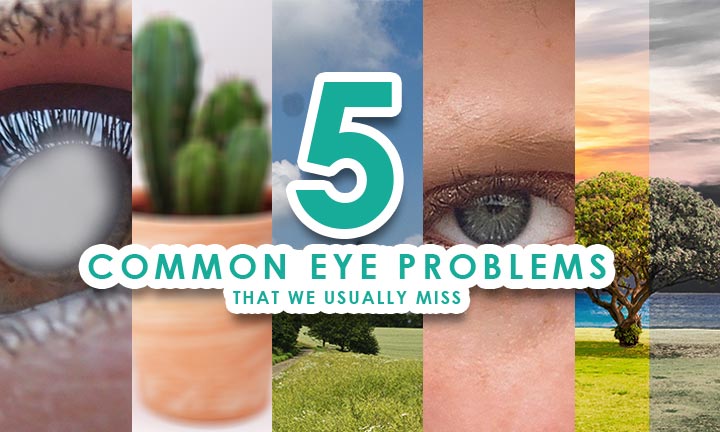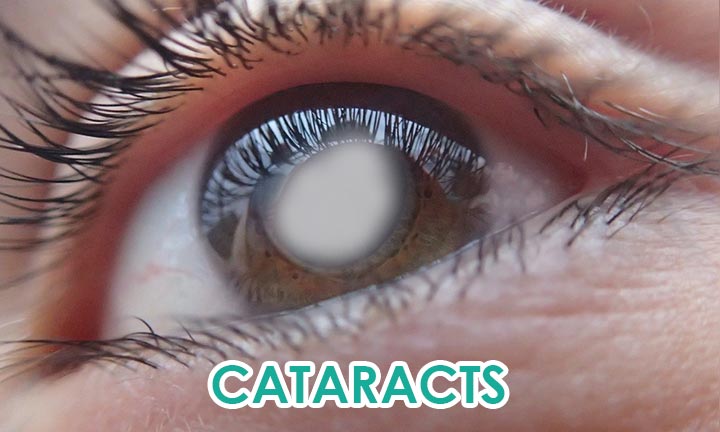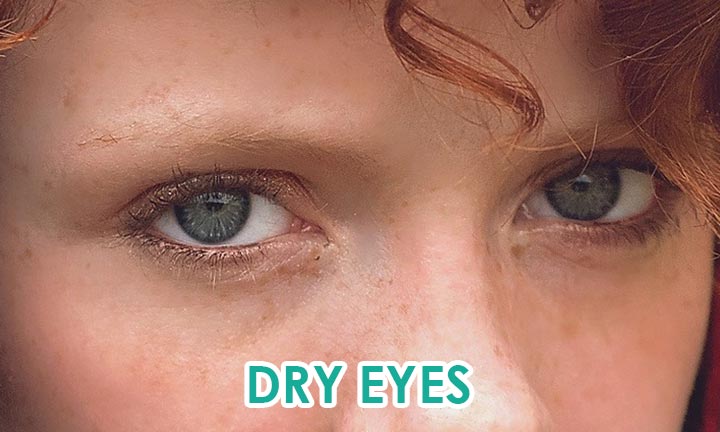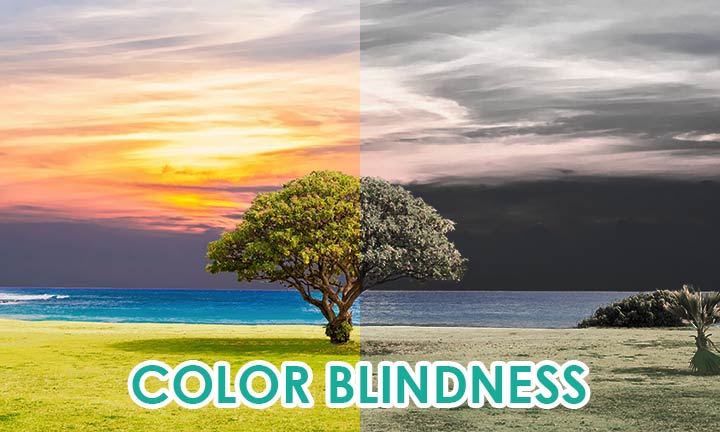5th, September 2019 | Oh Jinna
5 Common Eye Problems That We Usually Miss

I’m pretty sure we’ve all had eye problems at some point in our lives. Most of our eye problems are usually nothing serious. However, some of these seemingly simple eye problems may lead to something serious if left unchecked.
Whether you have eye problems or not, it is always better to be aware of common eye problems that we usually miss.
Here some of the most common eye problems that you might find interesting to know about:
1. Cataracts

Our eyes have a clear lens that allows light to refract so that we can see. When you havecataracts, your eye becomes clouded. People with cataracts see the world as if looking through foggy camera lenses.
This vision problem makes reading, driving, and other daily activities difficult.
Most of the time, cataracts that develop slowly are not very noticeable. It might not even bother you as it develops.
What are the symptoms of cataracts?
There are some telltale signs that you can look out for to know if you have cataracts.
- Is your vision getting dim or blurry?
- Do you find it more difficult to see at night?
- Are your eyes increasingly sensitive to glares or lights?
- Do you find yourself needing brighter lights when you read at night?
- Is your vision impairing your daily activities?
- Do you often see halos when you look at lights?
- Are you in frequent need to change your eyeglasses or contact lenses?
- Do the colors start to fade or turn yellowish?
- Have you had problems with double vision when you close one eye?
Eyeglasses and very bright lights can help with your vision problems. But if your vision becomes too impaired, that it affects your daily activities, you might need to consider having surgery.
Luckily, cataracts surgery is known to be a safe and effective procedure.
If you have any of the mentioned symptoms of cataracts, then you should schedule an appointment for an eye examination. The faster you notice the symptoms of cataracts, the better.
How can you prevent cataracts?
There aren’t any current studies that can prove how you can prevent cataracts. But the following suggestions may prove useful to you:
– Have your eyes checked regularly so that any possible complications in your eyes can be detected at an early stage.
– Avoid smoking cigarettes.
– Reduce your alcohol consumption.
– Be mindful of your health and stick to a healthy diet.
– Wear sunglasses to protect your eyes from the sun.
2. Refractive Errors

A refractive error is when the shape of your eye bends and does not focus on light correctly. When your eyes cannot focus light directly to the retina, you end up with a blurred vision.
Refractive errors also occur when your eyeball is shorter or longer than normal, your cornea changes shape, or the lens of your eyes age.
What are the causes of refractive errors?
You may be thinking that over straining your eyes is the main cause for refractive errors. However, the primary causes of refractive errors are as follows:
– Myopia – Also known as nearsightedness, is a common type of refractive error. When you have myopia, things that are near you look clear white things that are far away are blurred.
– Hyperopia – Also known as farsightedness, is the opposite of myopia. When you have hyperopia, you can clearly see objects that are far away but objects that are near you are blurred.
– Presbyopia – Is a type of farsightedness that happens when the lens in your eyes start to lose its elasticity. If you have presbyopia, you will find it difficult to focus your vision to nearby objects, such as reading a book.
– Astigmatism – develops when you have an asymmetric curvature in the the cornea of your eye. Generally, the cornea is smooth and has a proportionate curve towards all the directions of your eye.
However, if you have astigmatism, your eyesight becomes distorted because the curvature of you cornea is not equal. You might even experience a blurred eyesight at both close and far distances.
What are the symptoms of refractive errors?
If you think that you have refractive errors, you should be aware of the following symptoms:
– Do you have a blurry vision?
– Have you had problems with double vision?
– Do you need to squint your eyes to focus on objects?
– Is your vision getting hazy?
– Do you notice halos when you look at bright lights?
– Are you having constant headaches?
– Do your eyes feel stressed or worn out?
How do you fix refractive errors?
Refractive errors are common and are generally easy to deal with. Most of the time, prescription eyeglasses or contact lenses will do the trick.
If you don’t want any type of glasses or contact lenses, refractive surgery can fix some refractive disorders. Just remember to get your eyes checked by a professional before you start making any decisions.
3. Floaters

Floaters are small dark spots or specks that drift around your field of vision. They can also look like strands of thread or curly lines.
These little buggers are usually noticeable when you stare at bright objects, and can tend to move away from focus when you try to stare at them. Almost everyone has floaters in their eyes, they just don’t tend to mind them.
And of course, you most likely have floaters in your eyes too.
What are the causes of floaters?
A majority of your floaters are tiny specs of protein that are known as collagen. They come from the part of your eye that is known as the vitreous.
As you get older, the fibers of the proteins in your vitreous starts to shrink and form clusters. As they float around your eyes, they cast the shadows on your vision which we call floaters.
Floaters can appear any time, but are more common for people with ages between 50 to 75 years old.
If you have problems with being nearsighted, or you’ve had a cataract surgery, you are more likely to have floaters.
Should you see a doctor?
Floaters are pretty common and harmless, but if you should get your eyes checked if you notice any of the following:
– Do you see an alarming amount of floaters?
– Have you noticed a decrease in your side vision?
– Do you see flashes of light?
– Are there sudden changes that bother your vision?
– Have you noticed floaters after an eye surgery?
– Do you have eye pains?
If you feel like there is a problem with your vision, then you should definitely see a doctor who has experience with retina problems.
How do you treat floaters?
Normally, floaters don’t really need any treatment or medical attention. If they do bother you, just move your eyes around to remove them from your field of vision.
Or you can simply ignore them as they tend to become less noticeable when you are focused on other things.
4. Dry eyes

Dry eyes syndrome occurs when your eyes do not produce the right amount of liquid.
When your eyes become dry, they turn red, swell up, and start to get irritated. Having dry eyes can really bother your daily activities.
What are the symptoms of dry eyes?
Most of the time, the symptoms of dry eyes are more bothersome than alarming. However, some serious cases can be painful, and may cause more serious eye problems.
Check out the following signs to know if you have dry eyes:
– Do your eyes feel dry and sore?
– Are your eyes red?
– Do your eyelids feel sticky when you blink?
– Does your vision get blurry at times?
How do you treat your dry eyes?
Having dry eyes is not usually alarming. In Fact, you don’t need to get serious medical help to fix your dry eyes. Just make sure to avoid hot, dusty, or smokey places.
You can wear protective lenses to keep your eyes safe. Your eyes are more sensitive to dirt when they are not moist, so lenses can help keep the situation from getting worse.
Always keep your eyes as clean as possible and you can also use eye drops to moisten your eyes.
If your dry eyes persist and occurs regularly, a visit to an eye doctor may help.
5. Color blindness

If you notice that you don’t see color the same way that most people do, you might be color blind. Color blindness is a type of vision deficiency that affects how a person sees the different types and shades of colors.
Surprisingly enough, some people with this condition might not be aware that they are color blind until they get their eyes checked.
Color blindness is generally know to be passed down genetically, which means that you may inherit this condition from your ancestors.
What are the types of color blindness?
– Red-Green Color Blindness – Is the most common type of color blindness that occurs when your red cone and green cone photo pigments have a limited function. When you have this condition, you tend to see the red and green colors in a different way.
– Blue-Yellow Color Blindness – Occurs when the blue cone photo pigments of your eyes are missing or have a limited function.When you have this type of colorblindness, you generally have a hard time seeing blue and yellow colors.
– Complete Color Blindness – Is when a person does not see any type of color at all. When you are completely color blind, you tend to see the world in a monochromatic manner. Some severe cases leaves a person to see only black, white, and grey.
How do you treat color blindness?
There is currently no known cure to fix color blindness. But if you have red-green color blindness, you may be able to use special types of lenses that can help you see colors more accurately. You can also find features in modern devices that aid color blind users.
Color blindness does not normally affect the quality of life in a drastic manner. So if you are color blind, you won’t have to worry too much about your condition.
REFERENCES:
https://www.mayoclinic.org/diseases-conditions/cataracts/symptoms-causes/syc-20353790
https://www.umkelloggeye.org/conditions-treatments/refractive-errors
https://www.colourblindawareness.org/colour-blindness/embed/

Leave a Reply
You must be logged in to post a comment.